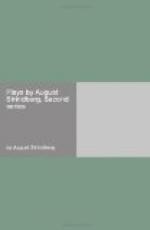“Then followed a period of comparative silence, and the drama sank back into the old ruts, until, with the beginning of the new century, Reinhardt opened his Kleines Theater. There I was played from the start, being represented by the long one-act drama ’The Link,’ as well as by ‘Miss Julia’ (with Eysoldt in the title part), and ‘There Are Crimes and Crimes.’”
He went on to tell how one European city after another had got its “Little,” or “Free,” or “Intimate” theatre. And had he known of it, he might have added that the promising venture started by Mr. Winthrop Ames at New York comes as near as any one of its earlier rivals in the faithful embodiment of those theories which, with Promethean rashness, he had flung at the head of a startled world in 1888. For the usual thing has happened: what a quarter-century ago seemed almost ludicrous in its radicalism belongs to-day to the established traditions of every progressive stage.
Had Strindberg been content with his position of 1888, many honours now withheld might have fallen to his share. But like Ibsen, he was first and last—and to the very last!—an innovator, a leader of human thought and human endeavour. And so it happened that when the rest thought to have overtaken him, he had already hurried on to a more advanced position, heedless of the scorn poured on him by those to whom “consistency” is the foremost of all human virtues. Three years before his death we find him writing as follows in another pamphlet “An Open Letter to the Intimate Theatre,” Stockholm, 1909—of the position once assumed so proudly and so confidently by himself:
“As the Intimate Theatre counts its inception from the successful performance of ‘Miss Julia’ in 1900, it was quite natural that the young director (August Falck) should feel the influence of the Preface, which recommended a search for actuality. But that was twenty years ago, and although I do not feel the need of attacking myself in this connection, I cannot but regard all that pottering with stage properties as useless.”
It has been customary in this country to speak of the play now presented to the public as “Countess Julie.” The noble title is, of course, picturesque, but incorrect and unwarranted. It is, I fear, another outcome of that tendency to exploit the most sensational elements in Strindberg’s art which has caused somebody to translate the name of his first great novel as “The Scarlet Room,”—instead of simply “The Red Room,”—thus hoping to connect it in the reader’s mind with the scarlet woman of the Bible.
In Sweden, a countess is the wife or widow of a count. His daughter is no more a countess than is the daughter of an English earl. Her title is that of “Froeken,” which corresponds exactly to the German “Fraeulein” and the English “Miss.” Once it was reserved for the young women of the nobility. By an agitation which shook all Sweden with mingled fury and mirth, it became extended to all unmarried women.




